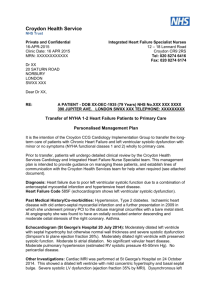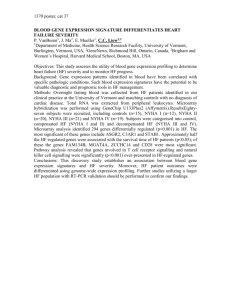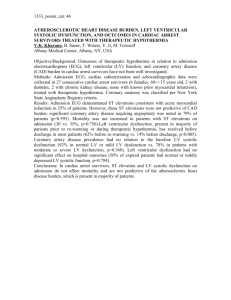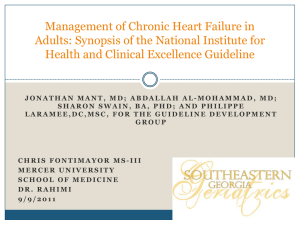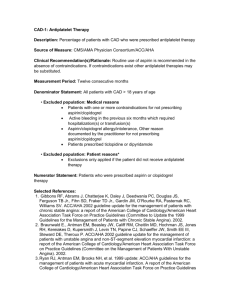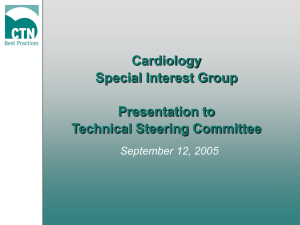files
advertisement
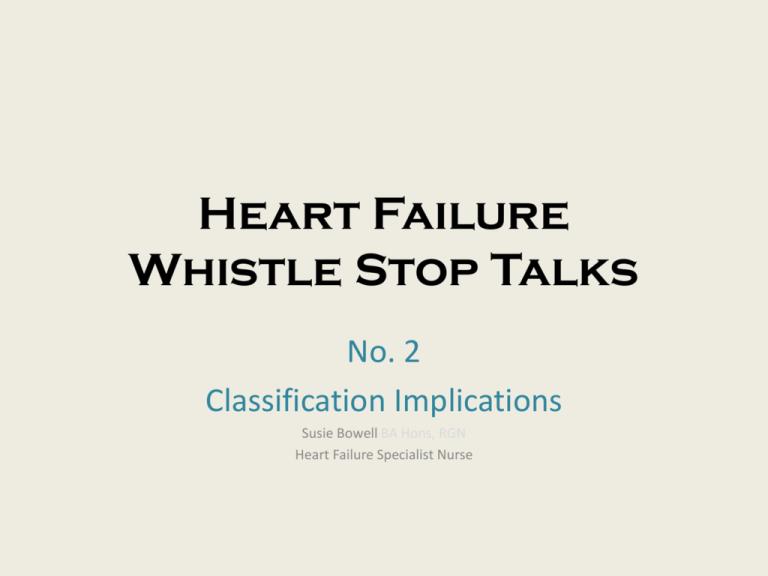
Heart Failure Whistle Stop Talks No. 2 Classification Implications Susie Bowell BA Hons, RGN Heart Failure Specialist Nurse Implications of classification Most commonly used is the New York Heart Association (NYHA), however the NYHA does not take into consideration the progression of HF from risk factors through asymptomatic dysfunction through to death. Accurate and appropriate classification reflects the changing understanding of the disease process and underlies – – – – – – – – – – Patient Care Study design and future research Acknowledgement of HF as a progressive disease process Early detection , recognition and prevention Presumed prevalence figures Disease understanding Treatment staging Prognostic assessment and understanding Public Health education, future health economics and health systems. The New York Heart Association (nyha) definition Classification NYHA Class 1 Symptoms No limitations of physical activity. No heart failure symptoms NYHA Class 2 Mild limitation of physical activity. Heart Failure symptoms with significant exertion; comfortable at rest or with mild activity Marked limitation of physical Activity. Heart Failure symptoms with mild exertion; only comfortable at rest NYHA Class 3 NYHA Class 4 Discomfort with any activity American Heart Association and American College of Cardiology (AHA and ACC) • In recognition that the development of HF is now considered to lie on a continuum, the AHA and ACC have devised a staging classification which emphasises this progression and the importance of early detection and prevention from asymptomatic disease to end stage heart failure. • Increasingly, population studies are taking into consideration risk factors and asymptomatic dysfunction when designing studies on HFrEF and HFpEF American Heart Association/American College of Cardiology (AHA/ACC) Stages of HF HF STAGE AHA/ACC GUIDELINE DESCRIPTION A Patients at high risk of developing HF because of the presence of a condition strongly associated with the development of HF. Such patients have no identified structural or functional abnormalities of the pericardium, myocardium, or cardiac valves and have never shown signs or symptoms of HF B Patients with structural heart disease that is strongly associated with the development of HF but without HF signs or symptoms C Patients with prior or current symptoms of HF associated with underlying structural heart disease D Patients with advanced structural heart disease and refractory symptoms of HF requiring specialised interventions ACC/AHA STAGES FOR TREATMENT Killip classification The Killip classification may be used to describe the severity of the patient’s condition in the acute setting after myocardial infarction Killip classification is an independent predictor of early mortality after myocardial infarction (MI), and the presence of left ventricular systolic dysfunction (left ventricular ejection fraction <50%) and high Killip class predicts poor short-term prognosis Killip class is a strong predictor of long-term mortality, and patients with high Killip class and left ventricular systolic dysfunction post MI are at highest risk Killip classification • Killip class I includes individuals with no clinical signs of heart failure • Killip class II includes individuals with rales or crackles in the lungs, an S3, and elevated jugular venous pressure. • Killip class III describes individuals with frank acute pulmonary oedema. • Killip class IV describes individuals in cardiogenic shock or hypotension (measured as systolic blood pressure lower than 90 mmHg), and evidence of peripheral vasoconstriction (oliguria, cyanosis or sweating). Problems with classification • NYHA classification rarely remains static for patients and can change over a relatively short period of time even in the absence of medication/ treatment changes. • Patients may present acutely with NYHA class III or IV symptoms; however, at discharge after treatment, many patients are minimally symptomatic. Clinicians must then decide whether to apply NYHA class IV therapies or only class II therapies, which leads to some uncertainty. This approach may result in the under-treatment of some patients with severe LV dysfunction who might be only mildly symptomatic. 2 • This is when the AHA/ACC staging may be considered useful as a guideline for treatment purposes as it takes into consideration underlying structural changes and not simply patient symptoms. This staging is not currently used within the NICE or ESC guidelines for heart failure, however, the treatments advised are the same and may be used to assist understanding in the staging of HF treatment when a patients symptoms alter. Important to note Symptom severity correlates poorly with structural ventricular function Although there is a clear relationship between severity of symptoms and patient survival, patients with mild symptoms may still have a relatively high risk of hospitalization and sudden death. bibliography • • • • • • 1. NICE Heart Failure Guidelines 2010 2.European Society of Cardiology Heart Failure Guidelines 2012 3. Management of Asymptomatic Patients with Reduced Left Ventricular Ejection Fraction, Heart Failure Society of America Guidelines, 2010 4. Vinereanu D, Nicolaides E, Tweddel A. C, Fraser A. G. (2005). “Pure” diastolic dysfunction is associated with long-axis systolic dysfunction. Implications for the diagnosis and classification of heart failure. European Journal of Heart Failure >Volume 7, Issue 5> Pp. 820-828 5. Parakh K, Thombs BD, Bhat U, Fauerbach JA, Bush DE, Ziegelstein RC. (2008) Long-term Significance of Killip Class and Left Ventricular Systolic Dysfunction American Assocation of Caridiology and American Heart Failure Association Guidelines

